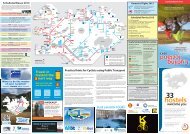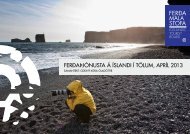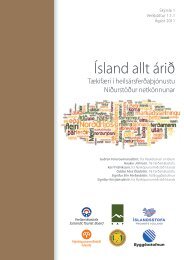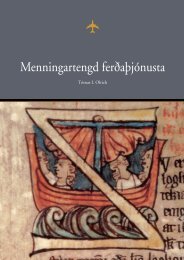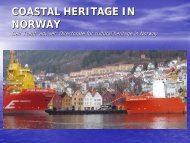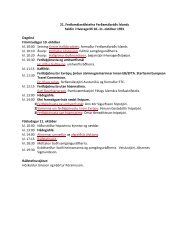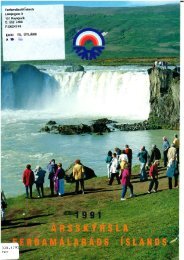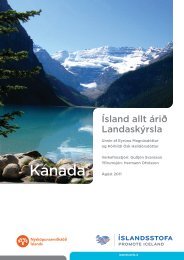Untitled
Untitled
Untitled
Create successful ePaper yourself
Turn your PDF publications into a flip-book with our unique Google optimized e-Paper software.
In the marketing of Iceland as a tourist destination, the country has<br />
also been further divided into Reykjavík and the capital area, East-Iceland,<br />
West-Iceland, South-Iceland, North-Iceland, The Westfjords, and The<br />
Highlands. In general, though, Iceland has sought to “market itself as an<br />
‘extreme’ and ‘different’ destination through the transformation of its<br />
history, culture, and nature into elements of ‘magic’” (Gössling 2006, p.<br />
122). As a “majestic country”, Iceland appears in books with titles such as:<br />
“‘Lost in Iceland’, ‘Magic of Iceland’, ‘Wonders of Iceland’, ‘Colours of<br />
Iceland’ or ‘Land of light’” (Gössling 2006, p. 122).<br />
The re-make and re-modelling through tourism imaginationings<br />
draw upon historical narration and myth. Horses are not only horses; they<br />
are Icelandic horses, and even “Viking horses”. The local beer is named<br />
“Viking”, the vodka “Eldurís” (Fire-ice) and “danger signs in many places<br />
enforce the notion of adventure and remnants of extreme events remind of<br />
the forces of nature” (Gössling 2006, p. 122). Even the hidden people are<br />
becoming suitable enough to be loaded with a high profile tourism<br />
exchange value. What else might there be besides the traditional mixture of<br />
nature and culture that could put a nation on the map of tourist<br />
destinations? Björk might not be considered an elf (or hidden person), but<br />
as potential tourism exchange value she is a point in case:<br />
When is an elf bigger than a nation? And if your’re the nation, what to<br />
do about it? In Iceland’s case, the answer seems to be: appreciate her<br />
[Björk] and ignore her (The New York Times, October 25, 2001).<br />
A general pattern in contemporary tourism pro-motional material of<br />
Iceland, identified by Gössling, is that of “exploration and adventure<br />
elements” (Gössling 2006, p. 122). And why not? Some people “still<br />
believe that the Icelanders, or some other people from among the northern<br />
nations, once sailed to the American shores prior to the voyages of<br />
Columbus” (Miles 1852, in Boucher, 1989, p. 17). About 50 years later, in<br />
2005, the president of Iceland enumerated 13 national characteristics to<br />
explain Icelanders success in finance:<br />
45



